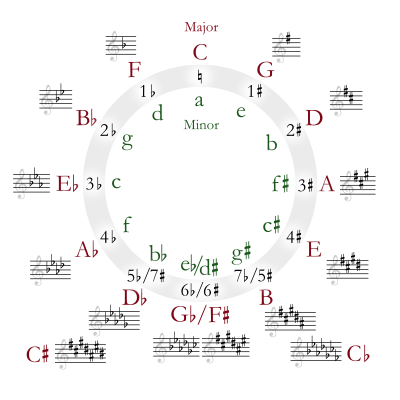Major scale

In music theory, the major scale or Ionian scale is one of the diatonic scales. It is made up of seven distinct notes, plus an eighth which duplicates the first an octave higher. In solfege these notes correspond to the syllables "Do, Re, Mi, Fa, Sol, La, Ti, (Do)". The simplest major scale to write or play on the piano is C major, the only major scale not to require sharps or flats, using only the white keys on the piano keyboard:
Structure

A major scale may be seen as two identical tetrachords separated by a whole tone, or whole step, the new set of steps "Whole:Whole:Half:Whole:Whole:Whole:Half"(in Semi-tone 2 2 1 2 2 2 1). Each tetrachord consists of two whole steps followed by a half step. Western scales do not skip any line or space on the staff, and they do not repeat any note with a different accidental. This has the effect of forcing the key signature to feature just sharps or just flats.
Named scale degrees
- 1st – Tonic- key note
- 2nd – Supertonic
- 3rd – Mediant
- 4th – Subdominant
- 5th – Dominant
- 6th – Submediant
- 7th – Subtonic (or Leading Tone)
- 8th – Tonic ( or Octave)
Scales with sharp key signatures
Sharp key signatures consist of a number of sharps between one and seven, applied in this order: F C G D A E B. The key note or tonic is immediately above the last sharp in the signature. For example, one sharp (F♯) in the key signature of a piece in a major key indicates the key of G major, the next note above F♯. (Six sharps, the last one being E♯ (an enharmonic spelling of F♮) indicate the key of F♯ major, since F has already been sharped in the key signature.)
C maj – 0 sharps G maj – 1 sharp – F♯ D maj – 2 sharps – F♯, C♯ A maj – 3 sharps – F♯, C♯, G♯ E maj – 4 sharps – F♯, C♯, G♯, D♯ B maj – 5 sharps – F♯, C♯, G♯, D♯, A♯ F♯ maj – 6 sharps – F♯, C♯, G♯, D♯, A♯, E♯ C♯ maj – 7 sharps – F♯, C♯, G♯, D♯, A♯, E♯, B♯
This table shows that each scale starting on the fifth scale degree of the previous scale has one new sharp, added in the order given above.
Scales with flat key signatures
Flat key signatures consist of one to seven flats, applied as: B E A D G C F (same as the order of sharps, but reversed.) The major scale with one flat is F major. In all other flat major scales, the tonic or key note is indicated by the second to last flat. In the major key with four flats, for example, the penultimate flat is A♭, indicating a key of A♭ major.
C maj – 0 flats F maj – 1 flat – B♭ B♭ maj – 2 flats – B♭, E♭ E♭ maj – 3 flats – B♭, E♭, A♭ A♭ maj – 4 flats – B♭, E♭, A♭, D♭ D♭ maj – 5 flats – B♭, E♭, A♭, D♭, G♭ G♭ maj – 6 flats – B♭, E♭, A♭, D♭, G♭, C♭ C♭ maj – 7 flats – B♭, E♭, A♭, D♭, G♭, C♭, F♭
In this case each new scale starts a fifth below (or a fourth above) the previous one.
The circle of fifths
The Circle of Fifths provides a useful way of seeing the relationship between musical keys.
The numbers inside the circle show the number of sharps or flats in the key signature, with the sharp keys going clockwise, and the flat keys counterclockwise from C major (which has no sharps or flats.) Six sharps or flats make the enharmonically identical keys of F♯ or G ♭. Seven sharps or flats make major keys (C♯ major and C♭ major) that may be more conveniently spelled with five flats or sharps (as D♭ major or B major).
Harmonic properties
This section needs attention from an expert in Classical music. Please add a reason or a talk parameter to this template to explain the issue with the section. (November 2008) |
The major scale may predominate the minor scale in Western music because of its unique harmonic properties; in particular the major third is much stronger in the harmonic series (it is the 5th, 10th and 20th harmonic – see below) than the minor third (the 19th harmonic).
In other words, the first six notes of the harmonic series provide a consonant major chord, the fourth to sixth of which form a major triad, and seven of the nine notes between the 8th and 16th harmonics (the 7th and 15th overtones) are notes in the major scale in just intonation. See the following:

The major scale allows:
- three-part major or minor chords, both stable and consonant, on every scale degree but the seventh
- a diminished fifth within the seventh chord built on the fifth degree, the dominant
- motion by a minor second from the leading tone to the tonic
- root motion by perfect fifths, the strongest root motion, from nearly every degree in either direction, the two exceptions being up a perfect fifth from the seventh degree, and down a perfect fifth from the fourth degree
See also
- Minor scale
- Enharmonic
- Equal temperament
- Just intonation
- Lydian mode
- Major and minor
- Music theory
- Tetrachord
External links
- Proper fingering of the major and minor scales on the piano
- Listen to and download harmonised Major scale piano MP3s
- The major and pentatonic scales on the guitar in several positions
- The major scale for guitar in one position, with derivation


